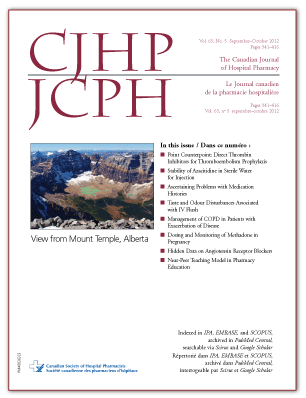Management of Chronic Obstructive Pulmonary Disease in Patients Admitted to a Tertiary Care Centre for Exacerbation of Their Disease
DOI:
https://doi.org/10.4212/cjhp.v65i5.1175Keywords:
acute exacerbation of chronic obstructive pulmonary disease, Canadian COPD guidelines, hospital admission, exacerbation aiguë de la maladie pulmonaire obstructive chronique, lignes directrices canadiennes pour la prise en charge de la MPOCAbstract
ABSTRACT
Background: Acute exacerbation of chronic obstructive pulmonary disease (COPD) is associated with an accelerated decline in lung function and a significant decrease in health status. Maintenance therapy with respiratory medications can reduce the risk of such exacerbations.
Objective: To determine whether respiratory maintenance medications were being prescribed in accordance with the 2007 COPD guidelines of the Canadian Thoracic Society for patients admitted to hospital for acute exacerbation of COPD.
Methods: A chart review was conducted for admissions to the Centre hospitalier universitaire de Sherbrooke, in Sherbrooke, Quebec, for acute exacerbation of COPD (according to diagnostic codes in the International Statistical Classification of Diseases and Related Health Problems, 10th revision) between January 1, 2008, and January 31, 2011. Data were extracted from patients’ medical charts concerning respiratory medications prescribed before the admission, during the hospital stay, and at discharge.
Results: A total of 846 hospital admissions involving 561 patients were reviewed. In almost 70% of admissions for which data were available on respiratory medications prescribed before the admission, during the hospital stay, and at discharge (238/341 [69.8%]), a combination of 3 medications was prescribed at discharge: tiotropium, a long-acting ß2 agonist, and an inhaled corticosteroid. For more than 80% of the admissions, a prescription for at least one inhaled long-acting bronchodilator was documented both on admission and at discharge. Few patients had a prescription for inhaled corticosteroid without long-acting ß2 agonist, but the number of admissions with a prescription for regular use of systemic corticosteroids increased at discharge.
Conclusions: Respiratory medications were generally prescribed in accordance with Canadian COPD guidelines, but improvements could be made regarding use of the combination of tiotropium, long-acting ß2agonist, and inhaled corticosteroid, as well as long-term use of systemic corticosteroids.
RÉSUMÉ
Contexte : L’exacerbation aiguë de la maladie pulmonaire obstructive chronique (MPOC) est associée à une réduction accélérée de la fonction pulmonaire et à un déclin notable de l’état de santé. Les médicaments respiratoires d’entretien peuvent réduire le risque d’une telle exacerbation.
Objectif : Déterminer si les médicaments respiratoires d’entretien ont été prescrits conformément aux lignes directrices de 2007 de la Société canadienne de thoracologie pour la prise en charge de la MPOC chez les patients hospitalisés pour une exacerbation aiguë de la MPOC.
Méthodes : Une analyse rétrospective des dossiers médicaux des patients hospitalisés au Centre hospitalier universitaire de Sherbrooke, à Sherbrooke (Québec), pour une exacerbation aiguë de la MPOC (d’après les codes diagnostiques de la Classification statistique internationale des maladies et des problèmes de santé connexes, 10e révision) entre le 1er janvier 2008 et le 31 janvier 2011 a été menée. Les renseignements sur les médicaments respiratoires qui ont été prescrits avant et pendant l’hospitalisation et au congé ont été extraits des dossiers médicaux des patients.
Résultats : Un total de 846 admissions à l’hôpital intéressant 561 patients ont fait l’objet de l’analyse. Dans presque 70 % des admissions pour lesquelles on disposait des renseignements sur les médicaments respiratoires prescrits avant et pendant l’hospitalisation et au congé (238/341 [69,8%]), une combinaison de trois médicaments a été prescrite au congé : le tiotropium, un ß2-agoniste à action prolongée et un corticostéroïde en inhalation. Dans plus de 80 % des admissions, une ordonnance pour au moins un bronchodilatateur à action prolongée a été consignée à l’admission et au congé. Peu de patients avaient reçu une ordonnance pour un corticostéroïde en inhalation sans un ß2-agoniste à action prolongée, mais le nombre d’admissions pourvues d’une ordonnance pour un corticostéroïde systémique était plus élevé lors du congé.
Conclusions : Les médicaments respiratoires ont été généralement prescrits conformément aux lignes directrices canadiennes pour la prise en charge de la MPOC, mais des améliorations pourraient être apportées concernant l’emploi du traitement associant le tiotropium, un ß2-agoniste à action prolongée et un corticostéroïde en inhalation, et l’utilisation à long terme d’un corticostéroïde systémique.
Downloads
Published
Issue
Section
License
Copyright © Canadian Society of Healthcare-Systems Pharmacy.
After publication of a manuscript in the CJHP, the authors of the manuscript must obtain written permission from the CSHP (publications@cshp.ca) before reproducing any text, figures, tables, or illustrations from the work in future works of their own. If a submitted manuscript is declined for publication in the CJHP, all said rights shall revert to the authors. Please note that any forms (e.g., preprinted orders and patient intake forms) used by a specific hospital or other health care facility and included as illustrative material with a manuscript are exempt from this copyright transfer. The CJHP will require a letter from the hospital or health care facility granting permission to publish the document(s).










